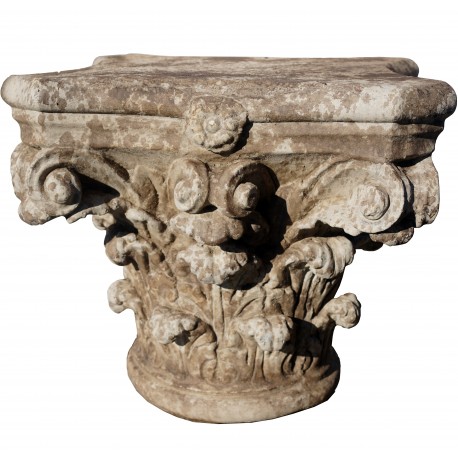patinate concrete Corinthian capital
It can support a weight of over 1,000 kg Copy of a Greek "Corinthian" capital.
Hand made in stone and concrete based on a cast, then patinated to perfection.
It weighs 95 Kg.
The Corinthian order (Latin Ordo Corinthius) is the last developed of the three principal classical orders of Ancient Greek architecture and Roman architecture. The other two are the Doric order which was the earliest, followed by the Ionic order. In Ancient Greek architecture, the Corinthian order follows the Ionic in almost all respects other than the capitals of the columns. When classical architecture was revived during the Renaissance, two more orders were added to the canon: the Tuscan order and the Composite order. The Corinthian, with its offshoot the Composite, is the most ornate of the orders. This architectural style is characterized by slender fluted columns and elaborate capitals decorated with acanthus leaves and scrolls. There are many variations.
The name Corinthian is derived from the ancient Greek city of Corinth, although the style had its own model in Roman practice, following precedents set by the Temple of Mars Ultor in the Forum of Augustus (c. 2 AD). It was employed in southern Gaul at the Maison Carrée, Nîmes and at the comparable Temple of Augustus and Livia at Vienne. Other prime examples noted by Mark Wilson Jones are the lower order of the Basilica Ulpia and the Arch of Trajan at Ancona (both of the reign of Trajan, 98–117 AD), the Column of Phocas (re-erected in Late Antiquity but 2nd century in origin), and the Temple of Bacchus at Baalbek (c. 150 AD).
- Height
- 46
- Weight
- 104
- Diameter of the base
- 32
- Historical period
- Temple of Apollo Epicurus at Bassae in Arcadia, c. 450-420 BC
- Maximum width
- 51 X 51
- Manufacturing
- Made in Italy
- Material
- Concrete
- Note 01
- The patina can be made on request more or less dark
- Note 02
- It can also be used as a base for classical sculptures or vases.
- Note 03
- A steel pin can be fixed in the center
- Historical references
- Corinthian order






